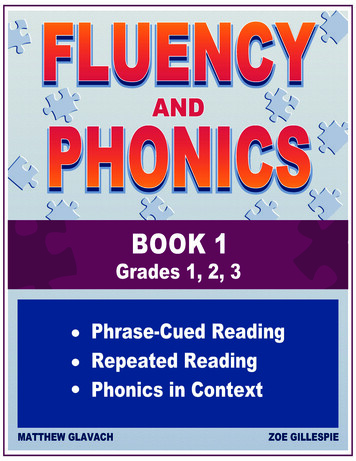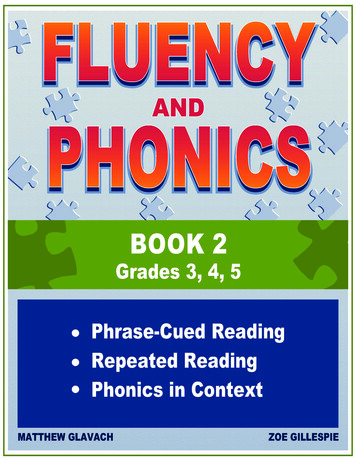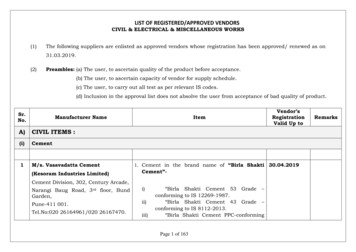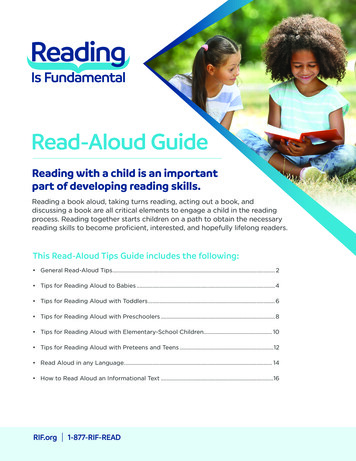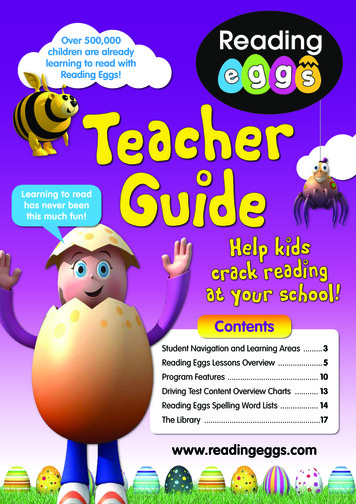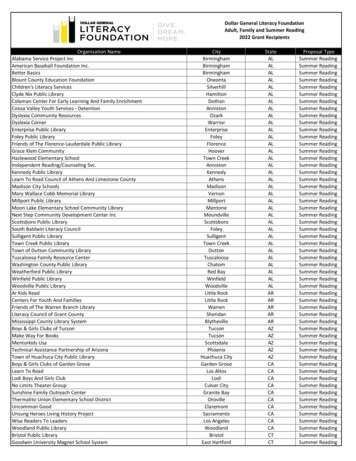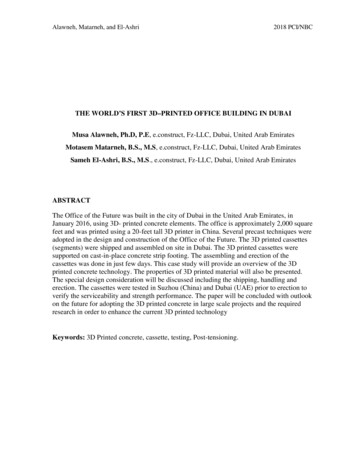
Transcription
TOJET: The Turkish Online Journal of Educational Technology – January 2014, volume 13 issue 1A STUDY ON READING PRINTED BOOKS OR E-BOOKS: REASONS FORSTUDENT-TEACHERS PREFERENCESNilgün TosunTrakya University, Faculty of Education, CEIT Department, Edirne, Turkey.nilgunt@hotmail.comABSTRACTThis study tried to determine the preferences of student-teachers on reading printed books or e-books and thereasons for these preferences. Reading printed books and e-books preferences of students are discussed in termsof gender and department variables. 258 student-teachers who are studying in Computer Education andInstructional Technologies (CEIT), Music Education (ME), Preschool Education (PE), Primary SchoolEducation (PSE), Social Sciences Education (SSE) and Turkish Language Education (TLE) departmentsparticipated in the research voluntarily. The students were asked five survey questions. To evaluate the datapercentage, mean, standard deviation and chi-square test were used. According to the answers given to thequestions prepared by the researcher, only 20.9% of the students currently read e-books. The rate of e-booksreading students is higher in CEIT and Social Sciences Education divisions than the other divisions. In anotherfinding of the study, male students read e-books more than female students. The reading rate of students whoprefer reading e-books to printed books is 96.5%, if the hardware and software requirements are met. This choiceis analyzed in terms of divisions; CEIT students prefer reading e-books to printed books less than the students ofother divisions. Same choice is analyzed in terms of gender; the rate of preferring to read e-books in femalestudents is higher than male students. The reasons for students preferring to read printed books to e-books are:25.6% "to protect my eye health" and 25.2% "I like holding the book in my hands" are the most given answers.These two responses were given mostly by the students of Primary School Education division. Also, the rate ofstudents who prefer printed books and give "to protect my eye health" as a reason is higher in CEIT division thanother departments. "I understand better when I read the book in my hand" preference reason is higher in CEITstudents with a rate of 5.5% than students in other departments. The response of “I do not have the technology toread e-books" is 1.6% and "I understand better when I read the book in my hand" response rate is 1.2%. In afurther finding of the study, the preference reason "I like holding the book in my hands" as expressed by femalestudents is 30.1%. This rate is 14.6% in male students.Keywords: E-books, Student-teachers, Reading book, Printed books.INTRODUCTIONThe development of the internet has led to the adding of a lot of concepts starting with “e-“ to our lives. E-mail,e-shopping, e-banking, e-commerce, e-government, e-signatures and e-learning are leading concepts amongthem. E-books with growing reader/user population are a book format that most of us have heard and used a lotlately because of their long-standing history and the widespread use of information technologies.With different definitions in the various sources, the e-book definition pertinent to this study is that of anelectronic format digitizing one or more printed books or a content completely produced in electronicenvironment that can be displayed, accessed, published on a desktop computer, on any hand-held device withscreen or in any custom-designed electronics. They will of necessity include a book reader hardware and richtext features software (adding bookends, text marking, note taking, etc.) to allow for the same functionsperformed during traditional reading (Önder, 2010).E-books can be read with numerous devices and tools. Such as Iriver eBook Reader, Oblio E-Book Plus, Kindle,ReederLITE, reedPAD2, eInk as well as desktops, tablet computers, iPhones and iPads, Blackberry’s, mobilephones, and navigation devices. Some portable music players and Nintendo DS gaming consoles, can also beused to read e-books (URL 1). In fact, it could be said that the increase in the number and types of hardware andsoftware required to read e-books is indicative of the rise in the number of e-books’ readers and e-books releasedby the publishing industry. In a study conducted to determine the rate of e-books reading, according to theresponses of 307 people; 22% stated that they read e-books, 77% stated that they do not (Gürcan, 2010). Theusers of İdefix Library application service that started in 2010, which allows people to read e-books in tabletsincreased 4 times to 150,000 people, compared to 2009. The number of e-book devices with e-ink screentechnology such as Kindle has reached 40,000 (URL 1). In 2011, the number of e-books published in Turkeywas 1314, in 2012 this figure increased to 2928 (Kocatürk, 2013). According to TÜİK (2013a) data, the highestincrease in published ISBN-encoded content in 2012 was in e-books with 152.4%. It appears that thedevelopment and proliferation of technology will continue to facilitate an increase in the number of e-bookreaders.Copyright The Turkish Online Journal of Educational Technology21
TOJET: The Turkish Online Journal of Educational Technology – January 2014, volume 13 issue 1Reading e-books comes with a lot of advantages for users compared to reading printed books. For example;using less paper, e-books take up less space and are easy to carry, searching and note-taking is much easier, thefont size can be changed as desired, purchasing is much faster and easier, preservation and protection is simple.E-books can be printed and published in a variety of file formats (HTML, PDF, LIT, PDB, etc.) (Day, 2001;Snowhill, 2001; McFall, 2005; Yıldırım et al, 2011). According to Rukancı and Anameriç (2003); e-books,depending on the technology, can provide enough interaction as between a teacher and a student. It can appeal tostudents with different learning styles and they can adjust their own reading and learning speed. In addition, it isclear that because of its visual and audio elements, e-books could facilitate learning and teaching, make it moreenjoyable and optimise the permanence of learning. This is why the Ministry of Education in Turkey has givengreat importance to the design and use of e-books within the FATİH Project. In this context, tablet computerswere distributed to students in pilot schools. By the time the project is completed all the students and teacherswill have had the opportunity to use e-books. For this reason, having knowledge and experience in the use of ebooks for student-teachers, who are training to become teachers, is important. The study thus looked for answersto such issues as whether student-teachers read e-books; the relationship of this situation between the differentdivisions in which they are studying and the role gender plays; reasons and preferences for reading or for notreading e-books or printed books, and whether the preferences change in line with gender and their subjectspecialism.METHODModel of the StudyThis study was conducted using screening technique which is a descriptive research model.Study GroupThe sampling group of the study is 258 students attending Trakya University Faculty of Education, studying inComputer Education and Instructional Technologies (CEIT), Division of Music Education (ME), Division ofPreschool Education (PE), Division of Primary School Education (PSE), Division of Social Sciences Education(SSE) and Turkish Language Education (TLE) departments. The students participated in the study voluntarily.Distribution of participating students by gender and the division in which they are studying are presented in[Table 1].Table 1: Frequency distribution of students by gender and departmentGroupsGenderDepartmentFrequency (n)Percentage .210.537.65.0100Data Collection ToolsTo collect research data, a form consisting of five questions prepared by the researcher was used. The questionsof the form, are: 1. Your Gender? 2. Your Division? 3. Do you read e-books? 4. If your answer is No, what arethe reasons you prefer reading printed books to e-books? (Can select more than one option.), 5. If hardware andsoftware requirements are met for reading e-books, which format of the same book do you prefer to read, printedformat or electronic format?Analysis of DataData acquired in research were analysed using SPSS 17.0 software program. To evaluate the data, descriptivestatistical methods (Number, Percentage, Mean, Standard Deviation) were used. To compare the quantitativedata with the relationship between two groups, chi-square test was used.Copyright The Turkish Online Journal of Educational Technology22
TOJET: The Turkish Online Journal of Educational Technology – January 2014, volume 13 issue 1FINDINGSAccording to the responses of student-teachers to the questions in the data collection tool, the followingconclusions are reached:Do you read e-books? 79.1% of the students answered “No”, 20.9% “Yes”. More than half of the studentsdon’t read e-books. Acquired data presented in [Table 2].Table 2: Frequency distribution: Students’ reading e-books statusGroupsDo you read e-books?Frequency (n)Percentage (%)Yes5420.9No20479.1Total258100What are the reasons for not reading e-books? (Can select more than one option) based on the responsesgiven by student-teachers; “Printed books cost less” reason is the most marked reason with 98.8%. “To protectmy eye health” and “I like holding the book in my hands” reasons are other two reasons most chosen. The mostimportant factor students prefer printed books is the cost. The frequency distribution of the students’ responsesto this question is presented in [Table 3].Table 3: Frequency distribution: reasons students are not reading e-booksGroupsI like holding thebook in myhandsPercentage (%)6525.26625.64015.541.6I get morepleasure4216.3I like the smellof the book83.131.241.625598.8103.9To protect myeye healthBecause it isportable andeasier to readMore realisticWhat are the reasons you preferreading printed books to e-books?Frequency (n)I understandbetter when Iread the book inmy handsI do not have thetechnology to reade-booksPrinted booksare more costeffectiveTo supportauthors ofprinted booksCopyright The Turkish Online Journal of Educational Technology23
TOJET: The Turkish Online Journal of Educational Technology – January 2014, volume 13 issue 1I get distractedwhen reading ebooksCannot give upthe habit ofreading printedbooksNo reason41.651.94316.7If hardware and software requirements are met for reading e-books, do you prefer to read the printed format orthe electronic format of the same book? Almost all the students (96.5%) responded with electronic book. Thepreferred format for reading is e-book, for the students. Students’ responses to this question are presented in[Table 4].Table 4: Frequency distribution of printed books/e-books reading preferences of students, if hardware andsoftware requirements are metGroupsIf hardware and software requirements are met to read ebooks, do you prefer to read the same book in printedformat or electronic format?E-bookPrinted BookTotalFrequency (n)Percentage (%)24996.593.5258100Between the status of reading e-books and the divisions student-teachers study is found significant relationship(X2 15.446; p 0.009 0.05). The question; Do you read e-books? 36.4% of CEIT students answered “Yes” and63.6% “No”; 15.6% of PE students said “Yes”, 84.4% of PE students said “No”; 100% of ME students said“No”; 18.5% of TLE students said “Yes”, 81.5% of TLE students said “No”; 18.6% of PSE students said “Yes”,81.4% of PSE students said “No”; 30.8% of SSE students answered “Yes”, 69.2% of SSE students said “No”[Table 5]. The rate of the students reading e-books in CEIT and PSE divisions is higher than the other divisions.Table 5: Chi-square test; the relationship between the status of reading e-books and divisions of readinge- n%n%n%n%N%n%n%books%30.Yes20 %36.4 7 %15.6 0 %0.05 %18.5 18 %18.6 454 %20.98X2 15.44%69.No35 %63.6 38 %84.4 21 %100 22 %81.5 79 %81.4 9204 %79.1 62p 0.009Total55 %100 45 %100 21 %100 27 %100 97 %100 13 %100 258 %100Between the status of reading e-books and genders of student-teachers is found a significant relationship(X2 12.687; p 0.000 0.05). 14.8% of female students read e-books, 34.1% of male students read e-books[Table 6]. The rate of male students reading e-books is higher than female students.Table 6: Chi-square test; the relationship between the status of reading e-books and genders of studentsGenderStatus ofreading %34.1X2 12.687p 0.000No150%85.254%65.9204%79.1Copyright The Turkish Online Journal of Educational Technology24
TOJET: The Turkish Online Journal of Educational Technology – January 2014, volume 13 issue 1Total176%10082%100258%100Between the preference of e-books or printed books and meeting the software and hardware requirements ofstudent-teachers to read e-books there is a significant relationship (X2 26.338; p 0.000 0.05). 85.5% of CEITstudents, 100% of PE students, 100% of ME students, 96.3% of TLE students, 100% of PSE students, 100% ofSSE students preferred e-books [Table 7]. Accordingly, the division with the lowest rate of preferring e-books isCEIT.Table 7: Chi-square test; relationship between preferring printed books/e-books when software and hardwarerequirements of students are met and their /pen%n%n % n%N% n%n%E-books47 %85.545 %100 21 %100 26 %96.3 97 %100 13 %100 249 %96.5PrintedX2 26.3388 %14.50%00 %01%3.70%00%09 %3.5booksp 0.000Total55 %100 45 %100 21 %100 27 %100 97 %100 13 %100 258 %100The relationship between reading e-books or printed books preference when software and hardware requirementsof student-teachers are met for e-books and the students’ genders is significant (X2 20.015; p 0.000 0.05).100% of female students, 89% of male students stated that they would prefer e-books instead of printed bookswhen the software and hardware requirements to read e-books are met [Table 8]. All the female studentspreferred e-books, presence of slight preference for printed books by male students is observed.Table 8: Chi-square test; relationship between students’ genders and reading printed books/e-bookspreference when software and hardware requirements of students are met to read 7673249%96.5E-books%100%89PrintedX2 20.0150%09%119%3.5booksp 0.000Total176%10082%100258%100CONCLUSION AND DISCUSSIONThe findings reveal that a large part of student-teachers do not read e-books. Also Woody et al. (2010) reportsthat even though students have the opportunity to access technology anytime and anywhere they want, there isstill a preference for reading printed books. According to Kakırman Yıldız (2012); three generations describe thedigital process; digital immigrants, digital hybrids and digital natives. Digital immigrants were born before 1970,digital hybrids were born in 1970-1999 and digital natives were born after 1999. The student-teachers who arethe sampling of this study were born in 1990-1994 so the students are digital hybrids. Digital hybrids, try to takeadvantages of technological facilities but they are not as competent as the digital natives. The paper is muchcloser and intimate to them. As Duran (2013) quoted the research findings of Jamali et al. (2009), Noordhidawatiand Gibb (2008) that because of the reasons of technological deficiencies and not having sufficient knowledgeand skills to read e-books, students are not expressing positive attitude and opinion towards reading e-books. In asurvey done by the Pew Internet, even though individuals aged 16 and over in Turkey usage rate of e-books hasincreased from 16% to 23% and a decline in the rate of reading and using printed books (URL 3), it is normalthat the sampling of this study is focused on printed books in relation to the digital generations.In another finding of the study, the student-teachers have indicated that the main reason they do not read e-booksis that printed books cost less than e-books. In Turkey, taxes are the biggest obstacle to e-books. VAT (ValueAdded Tax) is 8% on printed books and 18% for e-books (URL 3; Şahin, 2013). The result is that e-books arecostlier than printed books. Also, having the hardware and software required to read e-books warrants additionalexpenditure. Considering all these factors and the fact that the target audience is still students, who have othereducational expenses, it is not difficult to understand the rationale underpinning this result.Copyright The Turkish Online Journal of Educational Technology25
TOJET: The Turkish Online Journal of Educational Technology – January 2014, volume 13 issue 1The second reason marked by the students for not reading e-books is to protect the wellness of their eye. Thisfinding is consistent with the finding of Duran (2013)'s study conducted with 254 students of the Faculty ofEducation at Uşak University. In Duran (2013)'s study, the students stated that the most serious distress is eyestrain and back pain in spite of many positive sides of reading through the screen. Güneş (2009) in his workcalled “Efficiency in Screen Reading” indicates that reading on the screen has some difficulties than readingfrom paper. Screen pages move from top to bottom or bottom to top. The eyes of reader read the lines from leftto right horizontally. The eyes vacillate between these two opposing moves during reading, often losing orhaving difficulty finding the line during reading. In addition, eye movements going back to check forinformation is difficult in screen reading. In paper reading, eyes go back moving to top lines or paragraphs tocheck information, from time to time. This process is very difficult in screen reading. Because most of the time,the places to check do not appear on the screen. Therefore to read the information, it is necessary to shift the textto find the related place. This situation limits the movements of the eye and the ease of reading. In short, readingfrom screen, burdens the reader's eyes. Preferring printed books for the sake of their eyes’ health is an indicatorthat the students who formed the sampling of this study are also conscious technology users.Other two options most marked as the reasons for not reading e-books are "I like holding the book in my hands"and "I get more pleasure". Abdullah and Gibb (2008) in their research were of the view that when the readers aregiven the right to choose, they prefer printed version of a book to its electronic version and expressed thissituation as the habit of reading from paper (Öngöz, 2011). It can be said that because the student-teachers aredigital hybrids, the habit of reading from paper is predominant.Almost all of the students stated that they would prefer to read e-books instead of printed books when hardwareand software needs to read e-books are met. In the students' responses to the previous question, the highestchoice was printed books are more cost-effective than e-books. Therefore, reading e-books for student-teachersis costly and cost is an important factor in their preferences.Segmental distribution of e-books reading students, CEIT and PSE students are the most e-book readingstudents. The high rate of e-books reading of CEIT students than other departments’ students is because thestudents of CEIT division are more interested in the internet and information technologies, inside and outside ofclass than the students of other divisions. That both CEIT and PSE divisions’ students have a higher rate of ebook reading than other divisions’ students can be connected to the program they study or the areas they havespecial interest in and their ability to find more e-books for their specialism compared to other students.According to another finding obtained in research, the rate of male students reading e-books is higher thanfemale students. Duran (2013) in his study conducted with the student from the Faculty of Education at UşakUniversity, e-book reading dimensions of benefit, love and habit, determined a higher rate in male students thanfemale students. Whereas, in recent years, in many studies which analyzed the habit of reading printed books andthe attitudes in terms of gender variable, the rate was higher in female students (Demir, 2009; Aslantürk andSaracaloğlu, 2010; Bozpolat, 2010). This situation shows males are more interested in technology and internetand they spend more time and have the ability to use them than females. According to TÜİK (2013b)Information Society Statistics year 2012 values, the computer using rate of males between the ages of 16-74 is59% and 38.5% in females; the rate of using internet in males is 58% and 37% in females. However, the femalestudents’ rate is higher than male students when software and hardware requirements are met preferring e-booksto printed books which may be connected to female students needing these requirements more than the malestudents.Most of the student-teachers from CEIT division prefer reading printed books to e-books even though hardwareand software requirements are met. Because CEIT department students have to do many tasks and projects oncomputers they may feel weary of the screen, and desire to read printed books.In Turkey today 150 thousand people have the technology to read e-books and approximately 300 thousands ebooks are sold yearly. This rate is 4 percent in 1000 of total book market. However, this rate is around 13% inthe United States (URL 4). The absence of the right to broadcast digitally the existing books in inventory,hesitation due to piracy and illegal copying of publications in virtual environment and small number ofemployees with knowledge and experience of e-book typography are undermining e-book publishing in Turkey.Furthermore, high tax rate in e-books has negative impact on e-publishing (Şahin, 2013). Despite these factors,350 publishers operate e-publishing in Turkey. For example Arkadaş Yayınları has offered for sale more than310 thousand books in more than 50 languages from the internet (URL 5). The number of e-books in İdefix is6002 (URL 6). As well as publishing houses some institutions and organizations have made significant efforts one-book publishing. For example, The Ministry of Education has continued the preparation of e-books and zCopyright The Turkish Online Journal of Educational Technology26
TOJET: The Turkish Online Journal of Educational Technology – January 2014, volume 13 issue 1books within the FATİH Project. TÜBİTAK called for the scope of Digital Content Open Course ResourcesSupport Program for university students in March 2013. With this project, an e-book pool will be developed toprovide both equality of opportunity and increased quality in undergraduate education for undergraduate studentsto exploit (URL 7).As a result, e-books are nowadays an important part of the education system and the publishing industry. Whenthe student-teachers who will be directly involved in the FATİH Project graduate, e-book literacy, at leastreadership will be an important factor. In Turkey, the legal framework should be made to increase the rate of ebooks reading, education programs should be provided for the publishing industry. In addition, regular activities,mainly for teachers or anyone who wants to gain knowledge and skills on how to use e-books should beorganized. These activities could be in the universities within the scope of relevant course curriculum or in theform of courses over the internet supported by visual materials. The ongoing lecture notes can be prepared in ebook format in distance education programs in many universities in Turkey, which can contribute to studentsgaining knowledge and experience in this regard. Standardization efforts on this subject should be accelerated. Inaddition, in the Department of Computer Education and Instructional Technology, with lessons such as E-BookDesign and Development, employees that the market requires, could be trained.In the context of expanding this research, suggestions listed below should be considered by researchers andpractitioners interested in the areas of this study:1. This study can be expanded by including all sections of the Faculty of Education.2. This study can be done by including all university students.3. E-book reading habit of the students can be assessed, by considering the following variables;a. Whether they have e-book reader and e-book reading software,b. Presence or absence of their own computers,c. E-books type they read,d. Whether they have the financial capability to buy e-books,e. Whether they buy licensed or pirated e-books,f. If they have information about e-books copyright law,g. If there is e-books reader in their family.4. The attitudes and opinions of the teaching staff on reading e-books can be explored.5. In line with requests and needs, co-operation between institutions on e-books designs and typographycan be improved.REFERENCESArslantürk, E. ve Saracaloğlu, A.S. (2010). Sınıf öğretmenlerinin ve sınıf öğretmeni adaylarının okuma ilgi vealışkanlıklarının karşılaştırılması. Anadolu Üniversitesi Sosyal Bilimler Dergisi, 11 (1), 155-176.Bozpolat, E. (2010). Öğretmen adaylarının okuma alışkanlıklarına ilişkin tutumlarının değerlendirilmesi(Cumhuriyet Üniversitesi Eğitim Fakültesi örneği). Zeitschrift für die Welt der Türken Journal of Worldof Turks. 2 (1), 211-228.Day, R. (2001). Reading the future. Popular Mechanics. 178 (4), 82-85.Demir, T. (2009). İlköğretim II. kademe öğretmen adaylarının okuma alışkanlıkları üzerine bir araştırma (GaziÜniversitesi örneği). Turkish Studies, 4 (3), 717-745.Duran, E. (2013). Investigation on views and attitudes of students in Faculty of Education about reading andwriting on screen. Educational Research and Review, Vol. 8 (5), 203-211, March 2013.Güneş, F. (2009). Ekran okumada verimlilik. (Retrieved on 15.06.2013 erimlilik/7725290)Gürcan, H.İ. (2010). E-kitap yayımcılığı ve uygulamaları. (Retrieved on 01.06.2013 from man Yıldız, A. (2012). Dijital yerliler gerçekten yerli mi yoksa dijital melez mi?, International Journal ofSocial Science, V. 5, Issue 7, 819-833, December 2012.Kocatürk, K. (2013). Türkiye’de E-Kitap Okuma Oranı Artışta. (Retrieved on 01.06.2013 p-okuma-orani-artista 88489 )McFall, R. (2005). Electronic textbooks that transform how textbooks are used. The Electronic Library, 23 (1).Önder, I. (2010). E-kitap olgusu ve Türkiye’de durum. Yayımlanmamış Yüksek Lisans Tezi. Ankara ÜniversitesiSosyal Bilimler Enstitüsü, Ankara.Öngöz, Sakine. (2011). Bir öğrenme-öğretme aracı olarak elektronik kitap. 5th International Computer &Instructional Technologies Symposium, 22-24 September 2011, Fırat University, Elazığ-TURKEY.Rukancı, F. ve Anameriç, H. (2003). E-kitap teknolojisi ve kullanımı. Türk Kütüphaneciliği, 17 (2): 147-166.Snowhill, L. (2001). E-books and their future in academic libraries. D-Lib Magazine, 10 (7).Copyright The Turkish Online Journal of Educational Technology27
TOJET: The Turkish Online Journal of Educational Technology – January 2014, volume 13 issue 1Şahin, M. (2013). Dijital Kitabın Önündeki Bariyer: Vergi. (Retrieved on 08.07.2013 dijital-kitabin-onundeki-bariyer-vergi.html)TÜİK (2013a). http://tuik.gov.tr/PreHaberBultenleri.do?id 13486, Retrieved on 17.06.2013.TÜİK (2013b). http://tuik.gov.tr/Ustmenu.do?metod temelist, Retrieved on 17.06.2013.Woody, W.D., Danie, D.B. ve Baker, C.A. (2010). E-books or textbooks: Students prefer textbooks. Computers& Education, 55, 945–948.Yıldırım, G., Karaman, S., Çelik, E. & Esgice, M. (2011). E-kitap okuyucuların kullanım deneyimlerine yönelikalan yazın taraması. 5th International Computer & Instructional Technologies Symposium, 22-24September 2011, Fırat University, Elazığ-TURKEY.URL 1. http://www.kitaptarama.com/e-kitap.aspx, Retrieved on 25.05.2013.URL 2. http://sosyalmedya.co/e-kitap-okuma-orani-artti, Retrieved on 17.05.2013.URL3. itap-okumaoran-artiyor.html, Retrieved on20.06.2013.URL 4. meger/, Retrieved on 10.07.2013.URL 5. http://www.arkadas.com.tr, Retrieved on 30.06.2013.URL 6. http://www.idefix.com, Retrieved on 30.06.2013.URL 7. gri metni-130401.pdf, Retrieved on 09.07.2013.Copyright The Turkish Online Journal of Educational Technology28
finding of the study, male students read e-books more than female students. The reading rate of students who prefer reading e-books to printed books is 96.5%, if the hardware and software requirements are met. This choice is analyzed in terms of divisions; CEIT students prefer reading e-books to printed books less than the students of


